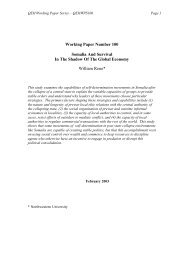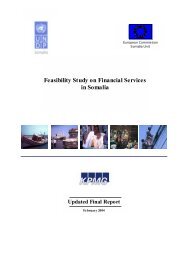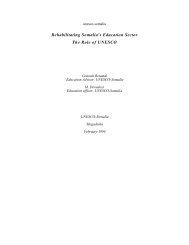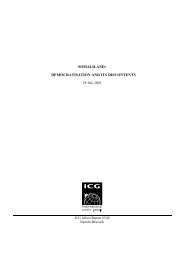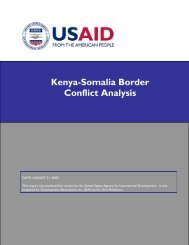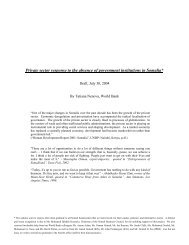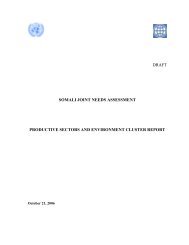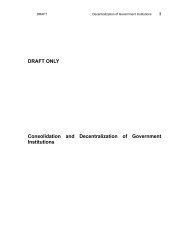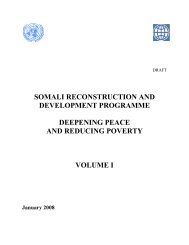Primary Education Survey Evaluation Report Somalia - Somali - JNA
Primary Education Survey Evaluation Report Somalia - Somali - JNA
Primary Education Survey Evaluation Report Somalia - Somali - JNA
You also want an ePaper? Increase the reach of your titles
YUMPU automatically turns print PDFs into web optimized ePapers that Google loves.
PES <strong>Evaluation</strong> <strong>Report</strong>, 2008<br />
In addition, the performance of enumerators and supervisors should be evaluated during the data<br />
collection phase by independent assessors, a report given to the staff member and this used as a basis for<br />
reemployment in the process the following year. One zone moved data collecting teams across regions<br />
where they were supervised by a different REO each year. In this way a more independent system of<br />
monitoring was created since over familiarity and old friendships could not influence work practice.<br />
Such a system could be considered by other zones.<br />
In undertaking the above recommendation it is necessary to remember the recommendation made above<br />
of conducting the data collection in a supportive environment. It needs to be remembered that these<br />
people are working in an environment where capacity is low and a major focus of the work is to develop<br />
that capacity. Hence, in implementing these proposals it is necessary to ensure that all staff are supported<br />
to develop the necessary skills and attitudes, are given support when needed and are encouraged to seek<br />
advice and support without fear of dismissal. Thus, it is imperative that a fine balance is recognised<br />
between commitment to quality and commitment to capacity development.<br />
It is worthwhile to make a note with regard to the future use of enumerators and supervisors as they are<br />
currently conceived. The more standard process for collecting data in an EMIS process is for head<br />
teachers to take responsibility for completing data forms and returning them to district/regional office.<br />
Currently this would be difficult to achieve due to the poor communication and transport infrastructure in<br />
many areas of <strong><strong>Somali</strong>a</strong>. As noted in an earlier section, a quality assurance and systematic monitoring<br />
structure has to be established before such data collection strategies can be used effectively. As capacity<br />
is developed and infrastructure built it is suggested that a more economic data collection system be<br />
developed. This could be achieved by abolishing the enumerator/supervisor structure and replacing it with<br />
an EMIS officer located in each regional office and head teachers be empowered to complete update of<br />
data forms along with subsequent data collection processes in the form of term or semester reports.<br />
3.2 Recommendations<br />
a. That the enumerators/supervisor position be competitively attained. It would be advisable to<br />
include more than the required number in the training process and only the best included in the<br />
data collection phase.<br />
b. That the performance of enumerators and supervisors be evaluated during the data collection<br />
phase by independent assessors using predefined competencies.<br />
c. That REOs be rotated across data collecting teams and thus create a more independent system of<br />
monitoring.<br />
d. That a fine balance is recognised between commitment to quality and commitment to capacity<br />
development.<br />
e. That as capacity is developed and infrastructure built the enumerator/supervisor structure be<br />
abolished and replaced with an EMIS officer located in each regional office and head teachers be<br />
empowered to complete update of data forms along with subsequent data collection processes in<br />
the form of term or semester reports.<br />
4 Timing<br />
4.1 Findings and Analysis<br />
In making comments with regard to the timing of data collection there are two areas in which<br />
considerations need to be made. One is the impact of timing on the data collection process, and the<br />
second is the suitability of timing of data collection for the process of collecting data and providing<br />
reports in a timely manner to ensure the maximum use of the data can be made and to help in avoiding the<br />
necessity for data duplication. By data duplication it is meant the need for people to pick up data in a<br />
parallel system that is also collected in the PES. Firstly, the impact of timing on the data collection<br />
process is considered. While it might not be possible to avoid all data duplication, a well designed EMIS<br />
process will attempt to minimise the need for data duplication.<br />
The current data collection process is undertaken in late April and May. The plan is for data to be<br />
collected over a two week period, but there are often delays and disruption to the process. This results in<br />
20



